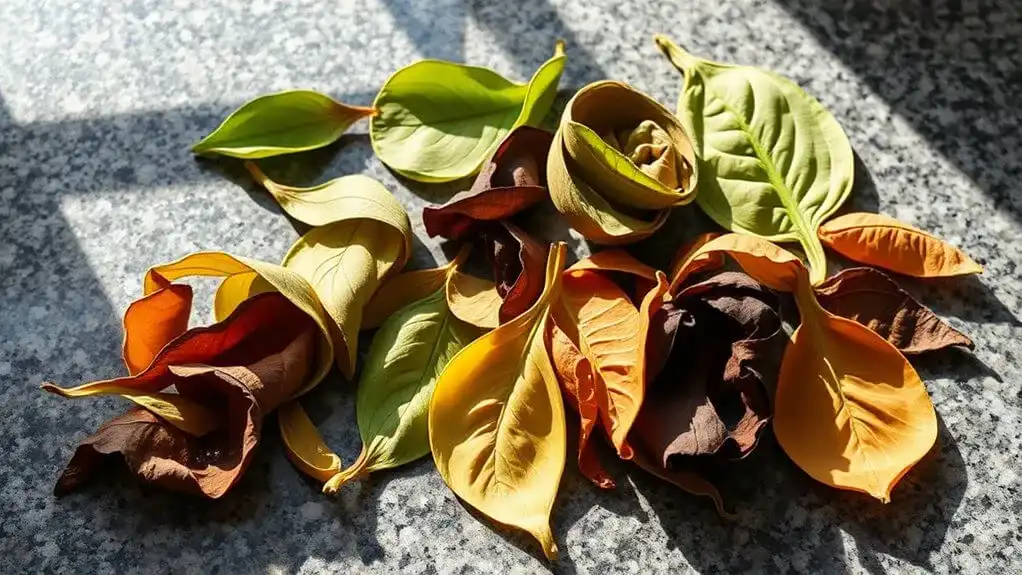Tea oxidation transforms flavors through a precise interplay of time, temperature, and humidity. During processing, damaged tea leaves release enzymes that convert catechins into complex compounds, creating distinct taste profiles. Less oxidized teas retain delicate, vegetal notes, while fully oxidized varieties develop rich, malty characteristics. The process requires careful monitoring between 80-90°F for ideal results. Understanding these factors reveals the secrets to tea's remarkable flavor journey.
Key Points
- Oxidation transforms tea flavors from light and fresh to deep and robust through enzymatic activity triggered by leaf damage.
- Temperature between 80-90°F and high humidity accelerate oxidation, leading to more pronounced flavor development.
- Longer oxidation periods produce darker teas with stronger flavors, while minimal oxidation preserves delicate, vegetal notes.
- Environmental conditions directly influence oxidation rates, affecting the final tea's aroma complexity and taste characteristics.
- Controlled oxidation timing allows producers to target specific flavor profiles ranging from sweet to malty and astringent.
Understanding Tea Oxidation Fundamentals
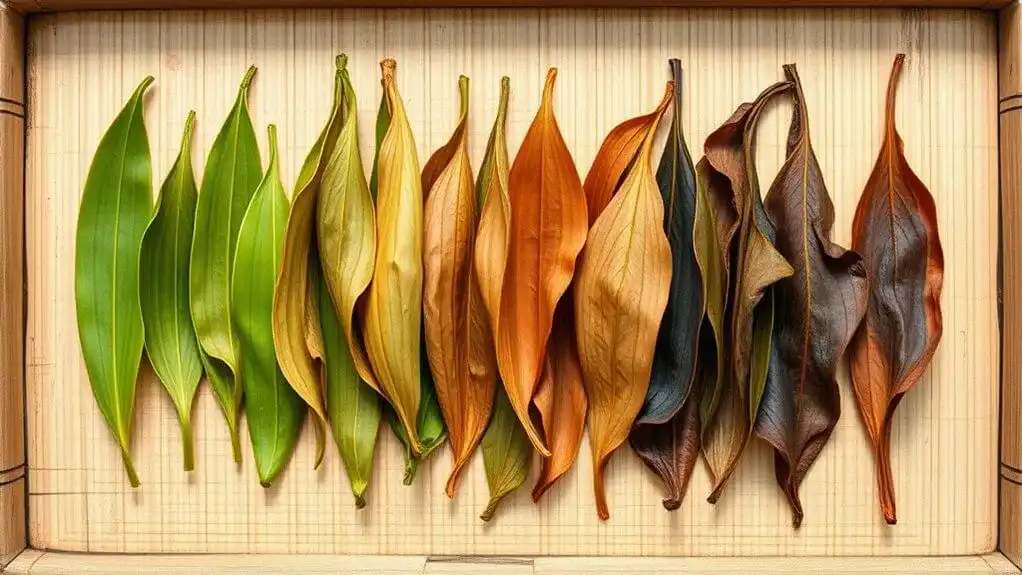
When tea leaves undergo processing, oxidation emerges as the most vital step in determining their final character. The oxidation mechanisms begin when cell walls are damaged through maceration, rolling, or tumbling, exposing the leaves' internal compounds to oxygen. This initiates critical enzyme activity, primarily involving polyphenol oxidase and peroxidase. Common fixing techniques like pan firing or steaming help tea producers achieve precise control over the oxidation process. Black tea is fully oxidized while others undergo varying degrees of this process.
During this transformation, polyphenols convert into theaflavins and thearubigins, which considerably influence the tea's briskness and color. The process works best at temperatures between 80-85°F, with various methods controlling the intensity of oxidation. Tea leaves are typically spread in layers of 10cm for optimal results. While CTC production uses rapid maceration techniques for mass production, traditional rolling methods offer a gentler approach. This fundamental process continues until it's deliberately halted through heating at approximately 150°F, which denatures the enzymes and stabilizes the desired flavor profile.
The Critical Role of Temperature and Humidity
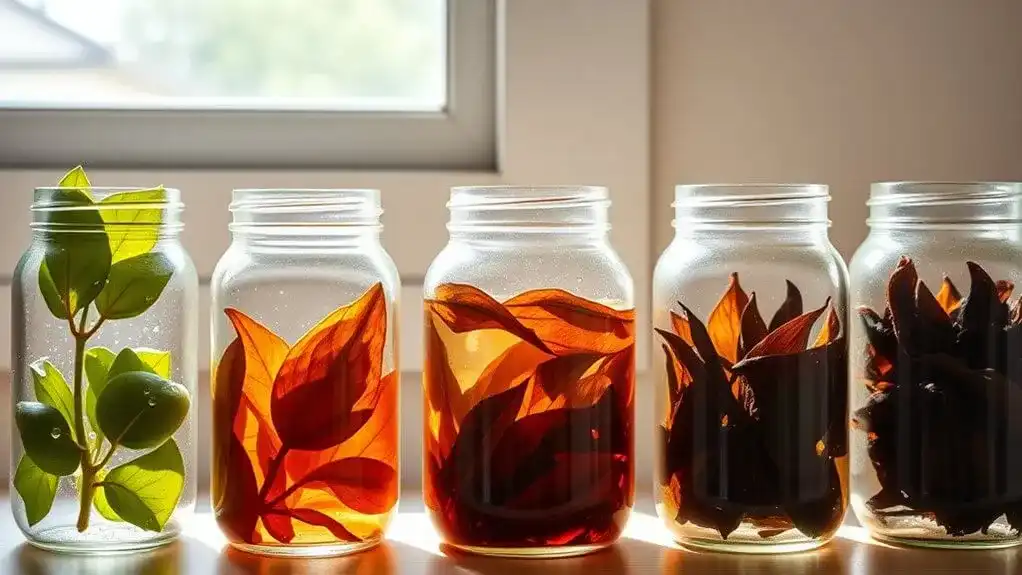
Temperature and humidity emerge as the primary drivers of tea oxidation's intensity and outcome. When temperature extremes reach 80-90°F, they activate oxidative enzymes, accelerating the transformation of catechins into theaflavins and thearubigins, which shape tea's distinct flavors.
Humidity fluctuations play an equally crucial role, as moisture levels directly influence enzymatic activity. Higher humidity promotes oxidation, particularly in oolong and black teas, affecting their color, flavor, and mouthfeel. The interplay between these environmental factors creates a complex dance of biochemical reactions that tea producers must carefully orchestrate. Tea masters maintain below 95°F temperatures to ensure optimal oxidation conditions and prevent damage to the leaves. Rolling and bruising of tea leaves helps initiate the oxidation process by breaking down cell walls. Fresh leaves undergo a significant transformation as bitter compounds diminish during the oxidation process.
To achieve specific tea types, producers balance these elements through techniques like steaming, pan-frying, and controlled drying. This delicate control determines whether leaves become white, green, oolong, or black tea, making oxidation management both an art and science.
Chemical Transformations During Oxidation
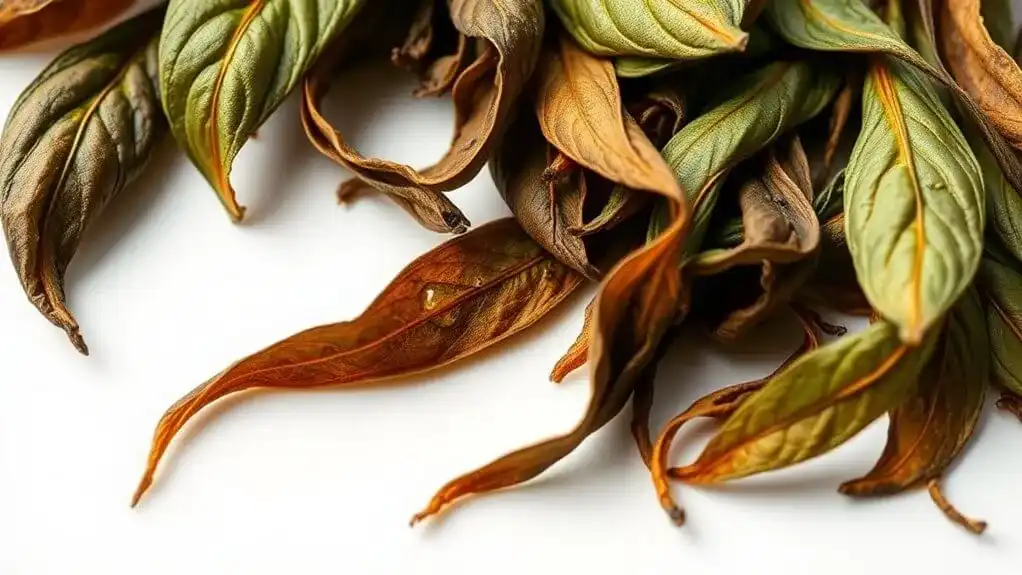
As tea leaves begin their transformative journey, a complex series of chemical reactions unfolds through the oxidation process. When leaves are bruised or cut, polyphenol oxidase enzymes are released, triggering enzymatic reactions that fundamentally alter the tea's composition. Higher altitudes typically result in slower oxidation rates, creating more nuanced flavor profiles.
During oxidation, significant chemical changes occur as catechins convert into theaflavins and thearubigins. These compounds are responsible for the distinctive flavors, colors, and aromas found in oxidized teas. The process resembles how an apple browns when exposed to air, but with tea, these changes are carefully controlled to achieve specific flavor profiles. The degree of oxidation determines the tea's classification, from the minimal processing of white and green teas to the full oxidation of black teas, each developing unique characteristics through this natural transformation. Pan frying or steaming is applied by producers to halt the oxidation process in green and white teas.
Mastering Oxidation Control Techniques
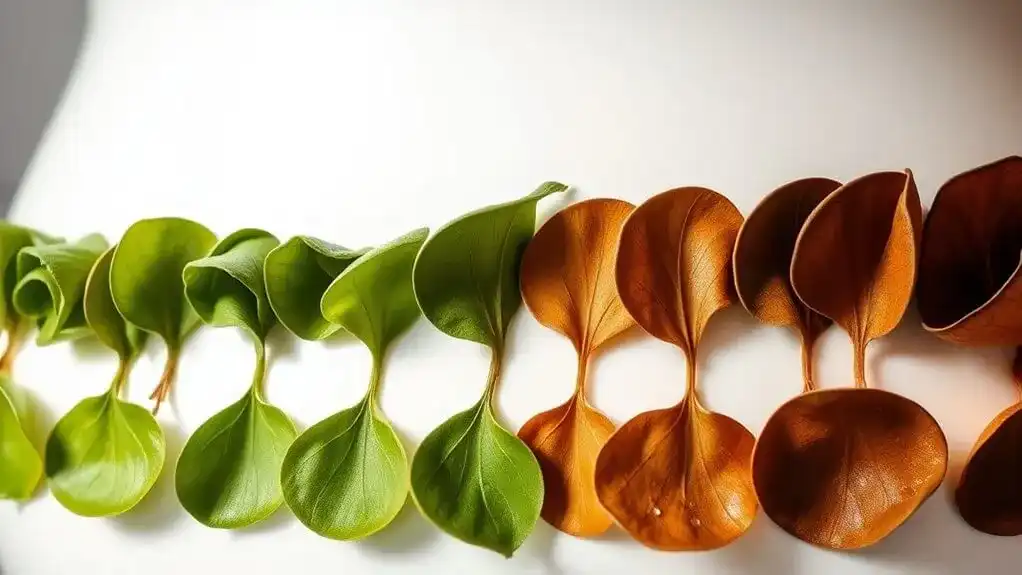
Successfully controlling tea oxidation requires mastering several precise techniques and environmental factors. Tea masters employ various oxidation techniques, from gentle tumbling to mechanical maceration, while carefully monitoring enzyme activation throughout the process. The environment plays an important role, with ideal conditions requiring temperatures between 80-85°F and humidity levels around 95%. The end result directly impacts the final aroma and flavor of the finished tea. Fresh tea leaves undergo artificial wilting before oxidation begins to achieve optimal moisture content.
- Rolling or tumbling techniques break cell walls to jumpstart oxidation while preserving leaf integrity
- Temperature and humidity control in specialized fermentation rooms guarantees uniform oxidation
- Monitoring the theaflavin to thearubigin ratio helps determine oxidation progress
- Heat application at precisely 150°F effectively halts the oxidation process
The process concludes when leaves achieve their characteristic aroma and color, typically taking 2-7 hours depending on the desired tea type. Proper moisture control and oxygen-rich air circulation remain vital throughout the oxidation period.
Effects on Tea Color and Appearance

During the oxidation process, tea leaves undergo dramatic color transformations as their chemical compounds interact with oxygen. The color spectrum shifts as catechins convert into theaflavins and thearubigins, creating rich reddish-orange hues. Meanwhile, chlorophyll breakdown reduces the initial green appearance, yielding deeper browns. This natural process is similar to when fruits start browning when cut and exposed to air.
Environmental conditions play an essential role in these visual changes. Higher humidity and warmer temperatures accelerate the oxidation rate, while altitude can slow it down, affecting the final visual appeal. All these changes stem from the same Camellia sinensis plant. Processing methods further influence the tea's appearance, with techniques like firing, steaming, and roasting contributing to distinct color variations. For instance, roasting can transform green tea leaves to brown, while deep steaming intensifies the green shade. The level of oxidation ultimately determines the tea's final color, ranging from light yellows to deep browns.
Impact on Flavor and Aroma Profiles
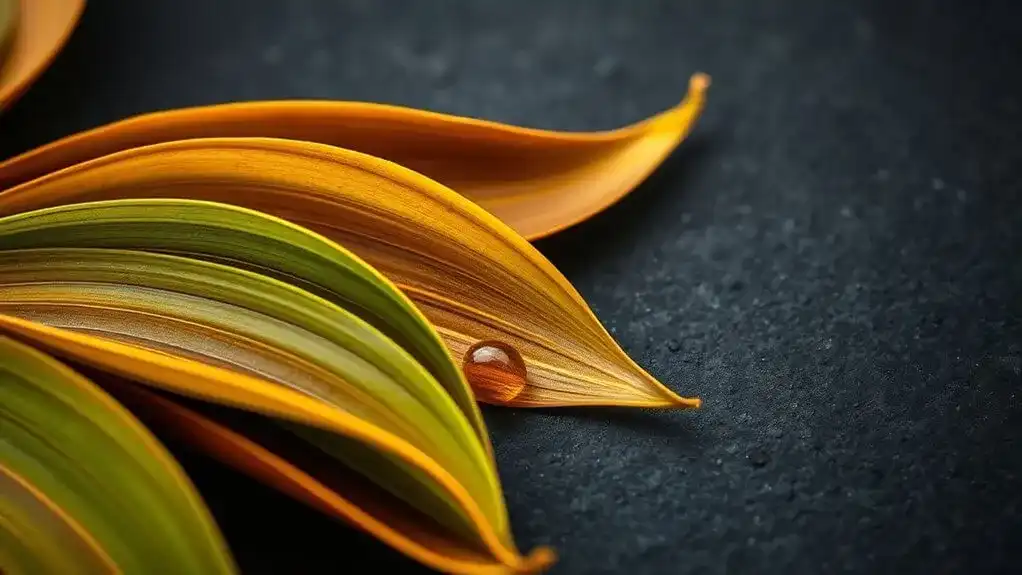
The chemistry of tea oxidation fundamentally shapes the beverage's flavor and aroma characteristics. As tea leaves undergo oxidation, their flavor evolution progresses from light and fresh to deep and robust. Less oxidized teas maintain vegetal and floral notes, while fully oxidized varieties develop bold, malty profiles. The aroma complexity increases with oxidation levels, creating distinct signatures ranging from grassy to smoky. The Sha Qing process helps preserve the natural green tea characteristics by halting oxidation through heat application.
- Less oxidized teas offer delicate sweetness with minimal astringency
- Partially oxidized oolongs present balanced profiles combining freshness with depth
- Fully oxidized black teas deliver rich, robust flavors with pronounced astringency
- Controlled oxidation timing allows producers to target specific flavor profiles
Tea makers carefully manage temperature, humidity, and rolling techniques to achieve desired taste characteristics, making oxidation control essential for developing distinctive flavor profiles in different tea varieties.
Health Benefits and Bioactive Compounds

Different oxidation levels in tea processing greatly influence the composition and concentration of bioactive compounds, which directly affect their health benefits. While white and green teas maintain high levels of catechins due to minimal oxidation, black tea develops complex theaflavins and thearubigins through extensive oxidation. These bioactive compounds contribute to various health benefits, from cardiovascular protection to cancer prevention. Studies have shown that tea drinkers exhibit significantly higher flavonoid levels compared to those who don't consume tea. Regular consumption can lower stroke risk by up to 16 percent when drinking at least two cups daily.
The transformation of polyphenols during oxidation creates unique profiles in each tea type. White tea's high catechin content makes it particularly potent in antioxidant effects, while oolong's partial oxidation offers a balanced mix that aids in weight management. Black tea's complex compounds support heart health, and all tea varieties contain L-theanine, which provides cognitive benefits. Additionally, the presence of fluoride across all tea types promotes dental health. Oolong tea, being semi-oxidized, combines elements from both green and black teas to deliver exceptional antioxidant properties.
Environmental Factors in Tea Processing
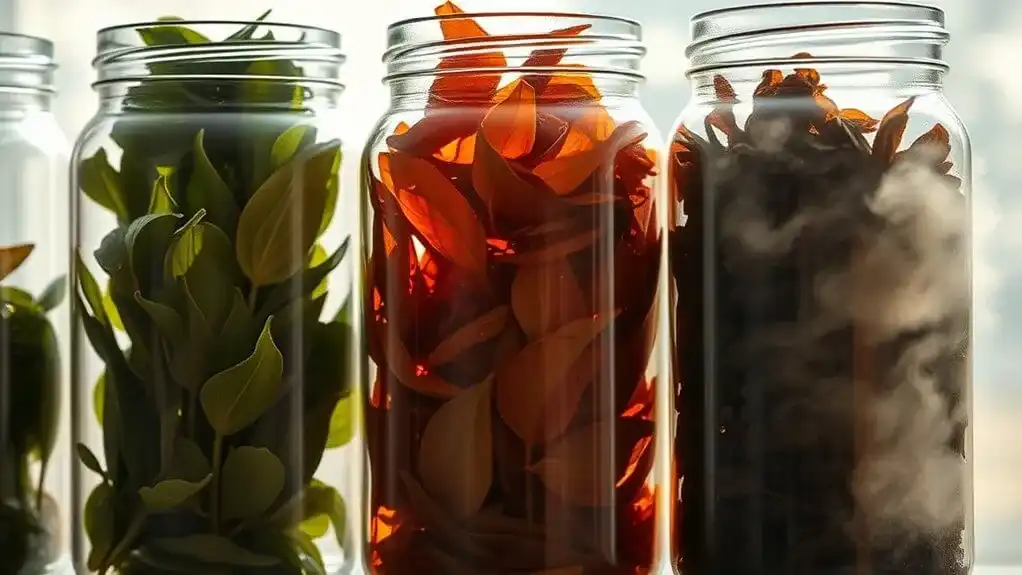
Modern tea processing faces significant environmental challenges that extend far beyond the cultivation fields. The environmental impact of tea production has become a critical concern as the industry grapples with resource-intensive processes and their effects on ecosystems. Growing tea in climate challenged regions is predicted to become increasingly difficult, with optimal areas in major producing countries expected to shrink significantly by 2050. The excessive use of chemical pesticides has led to toxic runoff that threatens local biodiversity and soil health. Sustainable practices are essential to address these challenges while meeting global demand.
Key environmental factors affecting tea processing include:
- Water consumption during withering and fermentation, requiring about 15 gallons for just 4 ounces of tea
- Energy usage in drying and processing stages, often relying on fossil fuels or wood burning
- Chemical runoff from processing facilities that can contaminate local water sources
- Soil quality impacts from intensive monoculture farming practices
These factors highlight the urgent need for more sustainable processing methods that minimize environmental damage while maintaining tea quality. Fair trade initiatives have become increasingly important to ensure both environmental sustainability and better working conditions for millions of tea industry workers worldwide.
The Art of Timing in Tea Oxidation
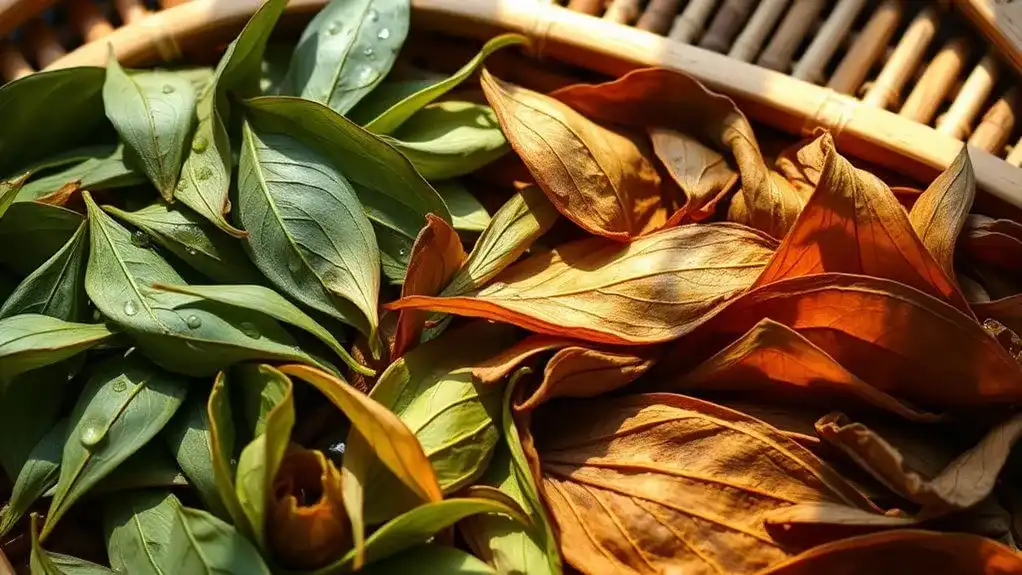
Mastering precise timing in tea oxidation stands as one of the most critical skills in tea processing, requiring both scientific understanding and artistic intuition. The tea master must carefully monitor oxidation timing while maintaining specific environmental conditions – 95% humidity and temperatures between 23-26°C – to achieve ideal flavor development.
The process begins immediately after plucking and intensifies during rolling, as cell walls break and enzymes interact with oxygen. Young spring buds containing high amino acid levels produce teas with superior umami characteristics. Tea masters control this transformation by managing warm, moist air exposure until the desired characteristics emerge. They know oxidation progresses best between 80-85°F and must decide precisely when to halt the process through heating or drying. This timing directly influences the tea's final color, aroma, and taste profile, with longer oxidation periods producing darker, more robust flavors.
Conclusion
Like a butterfly emerging from its chrysalis, tea leaves undergo their own metamorphosis through oxidation. Nature's clock and environment work together as master artists, painting each leaf with unique colors and flavors. While science explains the chemical dance, there's an undeniable magic in how time transforms these simple leaves into complex elixirs. It's a reminder that patience and precise conditions create life's most extraordinary treasures.
